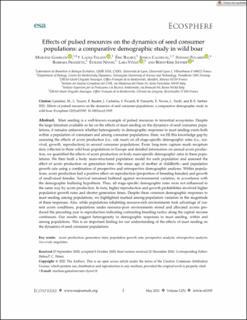| dc.contributor.author | Gamelon, Marlène | |
| dc.contributor.author | Touzot, Laura | |
| dc.contributor.author | Baubet, Eric | |
| dc.contributor.author | Cachelou, Jessica | |
| dc.contributor.author | Focardi, Stefano | |
| dc.contributor.author | Franzetti, Barbara | |
| dc.contributor.author | Nivois, Eveline | |
| dc.contributor.author | Veylit, Lara | |
| dc.contributor.author | Sæther, Bernt-Erik | |
| dc.date.accessioned | 2022-09-20T07:25:17Z | |
| dc.date.available | 2022-09-20T07:25:17Z | |
| dc.date.created | 2021-03-26T09:13:33Z | |
| dc.date.issued | 2021 | |
| dc.identifier.citation | Ecosphere. 2021, 12 (5), . | en_US |
| dc.identifier.issn | 2150-8925 | |
| dc.identifier.uri | https://hdl.handle.net/11250/3019015 | |
| dc.description.abstract | Mast seeding is a well-known example of pulsed resources in terrestrial ecosystems. Despite the large literature available so far on the effects of mast seeding on the dynamics of seed consumer populations, it remains unknown whether heterogeneity in demographic responses to mast seeding exists both within a population of consumers and among consumer populations. Here, we fill this knowledge gap by assessing the effects of acorn production (i.e., oak mast) on all stage-specific demographic rates (i.e., survival, growth, reproduction) in several consumer populations. From long-term capture–mark–recapture data collected in three wild boar populations in Europe and detailed information on annual acorn production, we quantified the effects of acorn production on body mass-specific demographic rates in these populations. We then built a body mass-structured population model for each population and assessed the effect of acorn production on generation time—the mean age of mother at childbirth—and population growth rate using a combination of prospective and retrospective demographic analyses. Within populations, acorn production had a positive effect on reproduction (proportion of breeding females) and growth of small-sized females. Survival remained buffered against environmental variation, in accordance with the demographic buffering hypothesis. Thus, all stage-specific demographic rates were not influenced in the same way by acorn production. In turn, higher reproduction and growth probabilities involved higher population growth rates and shorter generation times. Despite these common demographic responses to mast seeding among populations, we highlighted marked among-population variation in the magnitude of these responses. Also, while populations inhabiting resource-rich environments took advantage of current acorn conditions, populations under resource-poor environments stored and allocated acorns produced the preceding year to reproduction indicating contrasting breeding tactics along the capital–income continuum. Our results suggest heterogeneity in demographic responses to mast seeding, within and among populations. This is an important finding for our understanding of the effects of mast seeding on the dynamics of seed consumer populations. | en_US |
| dc.language.iso | eng | en_US |
| dc.publisher | Wiley Open Access | en_US |
| dc.rights | Navngivelse 4.0 Internasjonal | * |
| dc.rights.uri | http://creativecommons.org/licenses/by/4.0/deed.no | * |
| dc.title | Effects of pulsed resources on the dynamics of seed consumer populations: a comparative demographic study in wild boar | en_US |
| dc.title.alternative | Effects of pulsed resources on the dynamics of seed consumer populations: a comparative demographic study in wild boar | en_US |
| dc.type | Peer reviewed | en_US |
| dc.type | Journal article | en_US |
| dc.description.version | publishedVersion | en_US |
| dc.source.pagenumber | 19 | en_US |
| dc.source.volume | 12 | en_US |
| dc.source.journal | Ecosphere | en_US |
| dc.source.issue | 5 | en_US |
| dc.identifier.doi | 10.1002/ecs2.3395 | |
| dc.identifier.cristin | 1901220 | |
| dc.relation.project | Norges forskningsråd: 223257 | en_US |
| cristin.ispublished | true | |
| cristin.fulltext | original | |
| cristin.qualitycode | 1 | |

